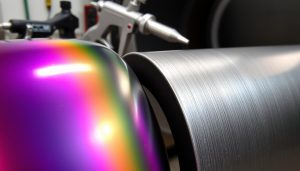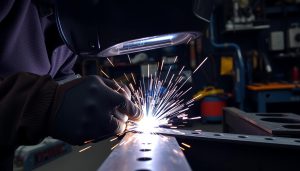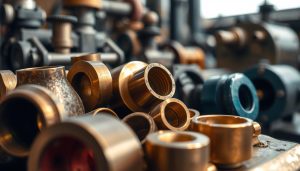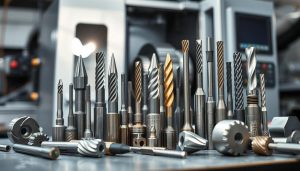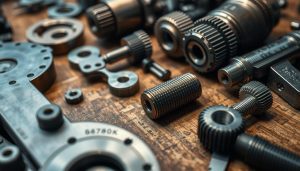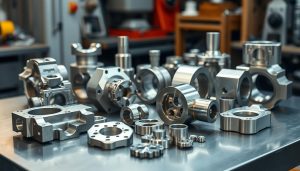In the dynamic world of modern manufacturing, the ability to precisely cut and shape metal components has become increasingly critical. From aerospace engineering to automotive manufacturing, the demand for precision metal cutting techniques has grown exponentially. This article delves into the intricacies of precision metal cutting, exploring the evolution of cutting methods and their impact on various industries.
The landscape of metal cutting has undergone a remarkable transformation, driven by advancements in technology and the ever-growing need for precision and efficiency. Gone are the days of relying solely on traditional tools and manual processes. Today, the metalworking industry has embraced a suite of cutting-edge techniques that have revolutionized the way we approach metal fabrication.
At the heart of this revolution lies the pursuit of precision, a crucial factor that has become the hallmark of modern manufacturing. Precise metal cutting not only enhances the quality and performance of the final product but also streamlines the production process, reducing waste and increasing cost-effectiveness. This comprehensive overview will delve into the various precision metal cutting techniques, their applications, and the factors that contribute to their success.
Introduction to Precision Metal Cutting
In the world of metalworking, the concept of precision metal cutting is paramount. This specialized technique goes beyond the traditional metal-cutting methods, offering a level of accuracy and control that is essential for modern manufacturing. Understanding the principles of precision metal cutting and its significance in the industry is crucial for anyone involved in metal fabrication.
What is Precision Metal Cutting?
Precision metal cutting refers to the advanced techniques used to shape, trim, or modify metal components with a high degree of accuracy and repeatability. Unlike conventional cutting methods, precision cutting employs advanced tools, machinery, and specialized processes to achieve superior accuracy in metal fabrication and minimize material waste.
Why Precision is Important in Metalworking
The importance of precision metalworking cannot be overstated. In today’s competitive manufacturing landscape, the ability to produce parts and components with exceptional metal cutting definition and consistency is a key differentiator. Precision metal cutting ensures that products meet strict specifications, improve overall quality, and enhance the efficiency of the manufacturing process.
- Improved product quality and performance
- Reduced material waste and manufacturing costs
- Enhanced production efficiency and faster turnaround times
- Increased customer satisfaction and loyalty
By mastering the art of precision metal cutting, manufacturers can stay ahead of the curve, deliver superior products, and maintain a competitive edge in the industry.
“Precision is not just a luxury in metalworking; it’s a necessity for success in the modern manufacturing landscape.”
Common Metal Cutting Techniques
In the realm of precision metalworking, there are four primary techniques that have emerged as industry standards: laser cutting, waterjet cutting, plasma cutting, and CNC milling. Each of these advanced metal cutting techniques offers unique advantages and caters to specific project requirements. Let’s explore these methods in detail.
Laser Cutting
Laser cutting is a non-contact thermal process that uses a highly focused beam of light to melt and vaporize metal. This precise technique allows for intricate cuts and complex geometries, making it ideal for manufacturing parts with tight tolerances. Laser cutting is particularly well-suited for cutting thin, reflective metals such as stainless steel, aluminum, and brass.
Waterjet Cutting
Waterjet cutting is a versatile method that uses a high-pressure stream of water, often mixed with an abrasive material, to cut through a wide range of materials, including metals, ceramics, and composites. This non-thermal process produces clean, burr-free cuts and can handle thicker workpieces compared to laser cutting. Waterjet cutting is especially beneficial for cutting delicate or heat-sensitive materials.
Plasma Cutting
Plasma cutting is a thermal process that uses a high-temperature, ionized gas to melt and cut through metal. This technique is known for its speed and ability to handle thicker materials, making it a popular choice for heavy-duty metal fabrication. Plasma cutting excels in cutting steel, aluminum, and stainless steel, and it can produce clean, precise cuts with minimal distortion.
CNC Milling
CNC (Computer Numerical Control) milling is a subtractive manufacturing process that uses a computer-controlled machine tool to precisely shape and cut metal workpieces. This versatile technique allows for the creation of complex geometries, intricate features, and tight tolerances. CNC milling is widely used in the production of prototypes, custom parts, and small-to-medium-sized production runs.
Each of these advanced metal cutting techniques has its own unique strengths and applications, making them valuable tools in the world of precision metalworking. By understanding the capabilities and limitations of these methods, manufacturers can make informed decisions when selecting the best approach for their specific project needs.

Factors Affecting Precision in Metal Cutting
Achieving precision in metal cutting operations is a critical consideration for various industries, from manufacturing to aerospace. Several key factors can influence the accuracy and quality of the cutting process, and understanding these elements is essential for optimizing your metalworking projects.
Material Types and Their Influence on Precision
The properties of the metal being cut play a significant role in determining the precision of the final result. Harder, more abrasive materials, such as stainless steel or titanium, can be more challenging to cut with high accuracy, as they tend to cause more wear and tear on the cutting tools. Softer metals, like aluminum or brass, generally allow for greater precision due to their reduced resistance to the cutting process.
The Role of Cutting Speed and Tool Selection
Proper cutting speed and the selection of the right tools are also crucial factors in maintaining precision. Cutting speed that is too high can lead to increased heat generation, which can distort the workpiece and result in inaccurate cuts. Conversely, cutting speed that is too low may cause excessive tool wear, reducing the tool’s ability to maintain a precise edge. Choosing the appropriate cutting tools, such as high-quality carbide or ceramic inserts, can also have a significant impact on the overall precision of the metal cutting operation.
Environmental Factors in Precision Metal Cutting
The environment in which the metal cutting takes place can also influence the precision of the final product. Factors such as temperature, humidity, and vibrations can all affect the stability and accuracy of the cutting process. Maintaining a controlled and consistent environment, with proper temperature and humidity regulation, can help ensure that environmental conditions do not compromise the precision of the metal cutting operation.
By understanding the impact of material properties, cutting speed, tool selection, and environmental factors, metalworking professionals can optimize their processes to achieve the desired level of precision in their metal cutting operations.
| Factor | Impact on Precision |
|---|---|
| Material Hardness | Harder materials are more challenging to cut precisely, while softer metals allow for greater accuracy. |
| Cutting Speed | Excessive speed can cause distortion, while too slow speed leads to tool wear and reduced precision. |
| Tool Selection | High-quality cutting tools, such as carbide or ceramic inserts, can help maintain a precise edge and improve cutting accuracy. |
| Environmental Conditions | Temperature, humidity, and vibrations can all affect the stability and precision of the metal cutting process. |

“Precision in metal cutting is the foundation upon which high-quality products are built. Understanding and optimizing the key factors that influence cutting accuracy is crucial for success in any metalworking operation.”
Choosing the Right Metal Cutting Technique for Your Project
Selecting the most appropriate metal cutting technique for your project can be a crucial decision, as it can significantly impact the overall quality, efficiency, and cost-effectiveness of your finished product. Whether you’re considering laser, waterjet, or plasma cutting, understanding the unique advantages and considerations of each method can help you make an informed choice that aligns with your specific requirements.
How to Decide Between Laser, Waterjet, and Plasma
Each metal cutting technique offers distinct benefits that may be better suited to different project needs. Laser cutting excels at producing intricate, high-precision parts with clean, narrow kerfs. Waterjet cutting can handle a wide range of materials, including delicate or heat-sensitive ones, without the risk of distortion. Plasma cutting, on the other hand, is often the most cost-effective option, making it an attractive choice for larger-scale projects or thicker metal components.
Key Considerations for Selecting the Best Cutting Method
When choosing a metal cutting technique, it’s essential to consider factors such as the material type, thickness, and desired finish, as well as the complexity of your design, production volume, and budget. Consulting with experts who can assess your specific requirements and guide you towards the most suitable cutting solution can help ensure the best outcome for your project.
How Shixinproto Can Help with Precision Metal Cutting
At Shixinproto, we are committed to providing our clients with exceptional precision metal cutting services. Our team of experienced professionals can help you evaluate your project needs and select the most appropriate cutting technique, whether it’s laser, waterjet, or plasma. With state-of-the-art equipment and a commitment to quality, we strive to deliver precise, reliable, and cost-effective results that meet your exact specifications.
